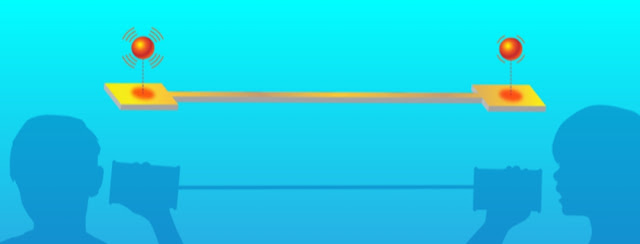Figure 1: Ions are coupled over long distance through a metal wire with a pad on each end—resembling a tin-can telephone. Each ion creates a mirror charge in the pad below it, and those charges can carry currents from one ion to the other. When researchers cooled one ion with lasers, they observed a cooling effect in the second ion.
As a kid, I developed my physical intuition by playing with toys. Bouncing balls and yo-yos demonstrated Newtonian dynamics; magnifying glasses introduced optics; drums and flutes gave the basis of acoustics. However, one toy defied my early understanding of the world: the tin-can telephone. By simply tying two empty cans together with a long piece of string and holding one can to my ear, I could hear the slightest whispers from a friend talking into the other can. It hardly made sense that a simple string could allow sounds to travel farther than they would in air. Two new experiments have demonstrated a scheme analogous to a tin-can telephone but based on a thin wire connecting two single ions trapped at remote locations. This connection allows the particles to sense each other at separations a thousand times farther than the range of direct interactions. The two research groups use their “tin-can telephones” to control the temperature of one particle with the other.
Physicists have long been trapping charged particles, and in the last 30 years, many laboratories have mastered trapping single ions, protons, and electrons. These experiments are at the frontier of research in quantum computing, optical clocks, and high-precision experiments that test fundamental laws of physics. Trapping charged particles is tricky, as the symmetries of electromagnetism do not allow static confining potentials in three dimensions—a limitation that goes by the name of Earnshaw’s theorem. However, several ingenious experiments have shown how to use dynamically varying potentials to trap charged particles.
Besides trapping, another tricky aspect is detecting the presence of trapped particles in the traps and controlling their motion and internal states. Since the early days of ion trapping, a common method has been to use one of the trap’s electrodes as a particle sensor. Once charged particles enter the trap, they generate “mirror charges” in the electrode. The movement of the trapped particles makes the mirror charges move, generating a measurable current. However, the mirror-charge method has lacked the sensitivity for controlling the motion of single particles inside the trap. Researchers have an alternative method to control single particles using light fields, but such a method only works for particles with accessible optical transitions. A desired goal in the trapping community is to make the mirror-charge method more effective for controlling the motion of single particles.
Two groups took up this challenge: Da An and collaborators at the University of California, Berkeley [1], and Matthew Bohman and collaborators at the Johannes Gutenberg University of Mainz, Germany [2]. The groups’ experiments showed that a pair of independent, single particles can sense each other through the mirror charges they generate in a nearby conductor in the form of a wire. In other words, they managed to create a single-particle tin-can telephone. Here, the vibration of the particle on one side induces a corresponding motion in the wire’s electrons. That electron response in turn affects the other particle at the far end of the line. Both groups use this “long-distance” connection for temperature control. Roughly speaking, they use the wire to send a “cooling message” from a cold particle on one side to a hot particle on the other. With separations of around a millimeter or more, the particles are too far apart to send this message through dipole or van der Waals interactions, which normally can’t be felt at separations greater than a micrometer.
In An and co-workers’ experiment [1], two calcium ions are trapped in independent traps 0.6 mm away from each other. These two traps were built on a planar wafer, with carefully etched surface electrodes. Most of these electrodes are designed to confine each of the particles, in the same way that planar traps are built for quantum computing with ions. However, the team’s trap setup has an extra electrode, which is a thin wire with a pad on each end. The ions levitate above these pads, which are like the tin cans of a toy telephone (Fig. 1).
To prove the connection between the two ions, the Berkeley team observed a change in the heating rate of their ions. Cold ions, if left alone, heat up because of various interaction mechanisms with their environment. When the researchers actively cooled one of the calcium ions with lasers, they observed that the other ion heated up significantly slower than would normally be the case. As the coupling between the ions was relatively small in this experiment, the researchers did not manage to cool the second ion but rather slowed down its heating by a factor of 2.
Bohman and collaborators [2], however, did manage to cool protons via a wire connecting them to laser-cooled beryllium ions at a distance of 9 cm. Their trick, well known to ion trappers, was to attach a resonator to the wire. The resonator (an LC circuit) enhanced the currents in the wire, thus making the overall particle-to-particle coupling stronger.
The resonator-enhanced interaction between the laser-cooled ions was strong enough to allow sympathetic cooling of single protons down to temperatures below 5 K. This temperature is still above the temperature of the laser-cooled ions, which are typically in the microkelvin range. Here, the cooling of the protons is limited by the temperature of the resonator, which is cooled with liquid helium to only a few kelvin. Researchers might be able to achieve lower proton temperatures by tuning the resonator frequency to an optimal value that maintains the strong particle-to-particle coupling while also lowering the resonator-to-particle heat transfer.
The ideas developed in these experiments are not new [3]. They were proposed by the pioneers of ion trapping back in the day. It took years of effort to reach this first clear demonstration of tin-can cooling. Further refinement could allow cooling of protons or other fundamental particles to microkelvin temperatures deep in the so-called quantum regime. With ultracold trapped protons, researchers could, for example, make precision measurements of the charge-to-mass ratio and of the gyromagnetic factor, which could reveal inconsistencies in the standard model of particle physics. On the more practical side, tin-can telephones might one day connect ion qubits, leading to new platforms for quantum simulation and computation.
References
- Da An et al., “Coupling two laser-cooled ions via a room-temperature conductor,” Phys. Rev. Lett. 128, 063201 (2022).
- M. Bohman et al., “Sympathetic cooling of a trapped proton mediated by an LC circuit,” Nature 596, 514 (2021).
- D. J. Heinzen and D. J. Wineland, “Quantum-limited cooling and detection of radio-frequency oscillations by laser-cooled ions,” Phy. Rev. A 42, 2977 (1990).



















